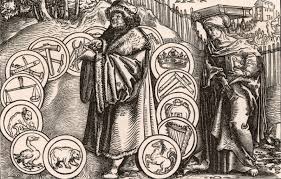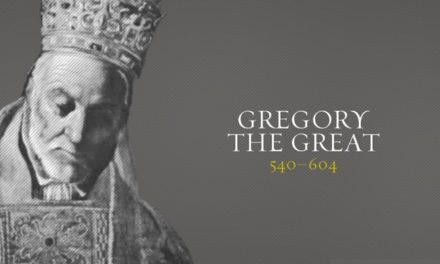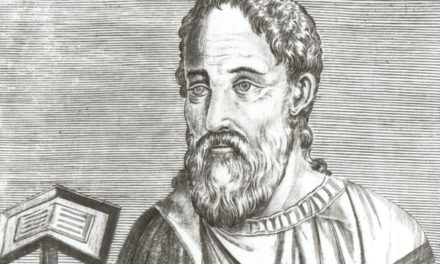The title of this episode is Scholasticism
One of the most important questions faced by philosophers and theologians throughout the centuries has been the interplay between Faith and Reason. Are they enemies or allies? Is the Christian faith reasonable, or a blind leap into an irrational darkness? A major advance in answering this came with the emergence of a group of medieval theologians known as the Scholastics. Chief among them were Anselm of Canterbury in the 11th C and Thomas Aquinas in the 13th.
In his novel Pillars of the Earth, author Ken Follett spins an intriguing tale of the construction of a cathedral in England. While the cathedral and town are fictional, Follett does a masterful job of capturing the mindset and vision of medieval architecture.
I’ve had the privilege of visiting the cathedral in Cologne, Germany a few times and am fascinated by what is found there. While some modern American evangelicals who decry tradition may be put off by all the elaborate decoration and religious symbolism of Europe’s Gothic cathedrals, most find them fascinating studies in art, architecture and with a little research, interesting expressions of theological thought. You see, the Gothic cathedral wasn’t just a building; it was an attempt to embody the period’s thoughts about God and man. As Bruce Shelly says, “The medieval masters of Gothic style tried to portray in stone and glass man’s central religious quest. They wanted to depict a tension. On one hand was man aspiring to reach the heights of heaven; on the other hand was God condescending to address the least of men.”
The pillars, arches, and steeples point up like fingers to heaven. But down comes the light through stained glass windows illuminating the Earth, and more specifically, those who’ve gathered inside to seek God. It is the architect’s version of human reason and divine revelation.
The schools these cathedrals housed gave rise to the universities of the late Middle Ages. Their task was to understand and explain Creation in light of God’s revealed Word and Ways. As the Crusades were an attempt to extend the authority of God over the Middle East, the universities hoped to extend an understanding of God and His creation over the realm of the mind.
But how did the world of ideas bow to the rule of God? How was reason to be made a servant of faith? This era in Christian thought is called “Scholasticism” because distinctive methods of scholarship arose and a unique theology emerged. The aim of the Scholastics was twofold: to reconcile Christian doctrine with human reason and to arrange the teachings of the Church in an orderly system.
But, it’s important we mark at the outset that a free search for truth wasn’t on the horizon for the Scholastics. The doctrines of the Christian faith were already fixed. The purpose of the Scholastics was to show the reasonableness of those doctrines and explain them.
The early universities were intimately linked to the Church. They were usually housed in the Cathedrals. A medieval scholar was most often a priest or monk. This began centuries before when Benedict of Nursia insisted monks study as a means of their spiritual development. In the 8th C, Charlemagne, while dreaming of a Christian empire, widened the opportunities for study through a decree that every monastery have a school to teach those able to learn. The Emperor himself set an example with a palace school for his children and court.
While the cathedral schools were set up primarily to train clergy, it wasn’t long before laymen were invited to attend as well.
The curriculum was limited to grammar, rhetoric, logic, arithmetic, geometry, music, and astronomy—the 7 liberal arts, so-called because in ancient Rome their study had been reserved for liberi = freemen. The few texts available were writings of a handful of scholars of the early Middle Ages. Students learned from Cassiodorus, Boethius, Augustine, Pope Gregory the Great, and a handful of Church Fathers the medieval student dared not question.
We can track the birth of the great medieval universities to the influence of several outstanding teachers. It was their skill in teaching and enthusiasm for learning that attracted students.
Among the first of this new breed of scholar was Gerbert, master of the cathedral school at Rheims [reems] in the latter half of the 10th C. Though he came from peasant stock, Gerbert became Pope Sylvester II. His genius was recognized early on so he was sent to study mathematics in Spain. While there, he was exposed to what at the time was the tolerant culture of the ruling Muslims. This was the first of a several significant contributions Muslims made to the Christian intellectual awakening of the Middle Ages.
Gerbert returned to Rheims greatly impressed by the inquisitive, questing spirit of Muslim scholars. When he began to teach, he announced that quotations of the so-called authorities were no longer going to be accepted as the final say. From then on, he required his students to study the classics in their original language. He began collecting manuscripts wherever he could and built a substantial library. This was no mean feat when we remember a manuscript could take a year to copy, and cost a fortune.
The most notable figure from this early period of Scholasticism was Peter Abelard. The senior son of a minor noble of NW France, Peter turned over his inheritance rights to his younger brothers so he could roam France and learn from the great masters. But he did more than listen. He challenged those he caught in factual or philosophical error. It wasn’t long before he settled in as a lecturer in Paris, where he attracted a host of students.
He also began to write. In a tract titled Yes and No, he posed over a hundred questions from Christian teaching, then answered them using conflicting quotations from Scripture, the Church Fathers, and even pagan classics. His point was that there were still many fronts for discussion and inquiry that needed to be resolved. Abelard said, “The first key to wisdom is assiduous and frequent questioning.… For by doubting we come to inquiry, and by inquiry we arrive at the truth.” This idea of using doubt to fuel the quest for knowledge was commonplace to the ancient Greeks but dangerous ground to medieval Europeans. Abelard had a few fans but many more detractors who were alarmed by his bold questioning of what were considered unimpeachable authorities. Having stirred one too many pots and poked one too many bee-hives, he decided to lay low for a while in a monastery.
A year later he left to live in an open area SE of Paris. Supporters built him a shelter, tilled his land, and begged him to teach once more. So, resuming his pursuit of reason, Abelard again fell out with the religious conservatives. It was at this point that Abelard ran afoul of Bernard of Clairvaux, the famous preacher of the 2nd Crusade and the most influential churchman in Christendom. Of Abelard, Bernard remarked, “The faith of the righteous believes, it does not dispute.” Bernard managed to have Abelard branded a heretic and excommunicated. Abelard retired to the abbey of Cluny, where its abbot, Peter the Venerable, persuaded Bernard to reconcile with Abelard. The excommunication was lifted. Abelard spent his last 2 years at the monastery at Cluny where he was regarded as a great scholar and wise counselor.
I’ll leave out of this Abelard’s marriage to Heloise, one of the most remarkable love-stories of history.
No one could stop the growth of the seeds Abelard planted. Schools popped up all over Europe. Less than 100 years after his death universities flourished at Paris, Orleans, and Montpellier in France; across the English Channel at Oxford and Cambridge; and at Bologna and Padua in Italy, all of them aflame with the ideas Abelard ignited.
Students and their teachers formed guilds. Just as craftsmen had done since the Roman Empire, scholars banded together for protection and promotion of their interests. They called themselves universitas, the medieval name for any corporate group.
Most students in Italy were grown men who pursued advanced study in law and medicine. Their guilds exercised tremendous power. Students paid teachers, determined the courses to be given, and fined any lecturer who skipped a chapter in expounding his subject. Certainly a turn around from today’s schools.
In English and French universities where students were younger, scholars’ guilds had the upper hand. They forbade swearing and gambling, fined students for breaking curfews, and set table manners.
Medieval universities, were not the ivied walls and grassy lawns we think of today. At first, lectures were given in shanties and sheds alongside roads at Oxford and Cambridge. They met in side rooms of the cathedral in Paris, open piazzas in Italy. Once the prestige and income of a teacher rose, he might rent a room for his students where they’d sit on straw-covered floors. Because they lacked any fixed property, they were able to move when they ran afoul of local authorities.
Along with lectures, teachers used what were called disputations. Two or more masters debated a text using Abelard’s question-and-answer approach. This was how Scholasticism developed. It arose from the pain-staking process of arriving at logical conclusions through questioning, examining, and arranging details into a system of logic. Scholastic disputations often caused heated clashes and bitter feelings. Wars of logic ran for years between different scholars, with supporters of each cheering their hero with loud whistling and stomping of feet. The point was, students were learning to think. The unquestioned acceptance of traditional authorities was no longer assured. Now, conclusions had to square with Christian doctrine.
Scholasticism was less a philosophy or theology as it was a method of learning. The emphasis was on harmonizing faith and reason. The Scholastics used the ancient Greek practice of relentless questioning of traditional authority. Truth would no longer be accepted just because those in authority said so. Truth was to be rigorously analyzed and brought over into the realm of reason. After all, didn’t the Bible say we are to love God with all our mind?
The Scholastics were known for their careful drawing of distinctions. In classrooms and books, topics were vigorously debated, with one of the sides of the debate not even really being believed but still proposed as a way to check the value of the side being affirmed.
Scholastics wanted to harmonize Christian theology with the philosophy of the classical era, especially that of Aristotle and the Neo-platonists.
Some scholastics of note are Alexander of Hales, Albertus Magnus, Duns Scotus, William of Ockham, and Bonaventure. Two of the greatest were Anselm of Canterbury and Thomas Aquinas. Aquinas’s masterwork, the Summa Theologica, is considered to be the greatest work of the Scholastics.
Anselm was born into one of the many noble houses of Europe in the early 11th C. Because there was little prospect for him to achieve prominence in the political realm, he became a Benedictine monk. His studies quickly marked him as a man of keen intelligence and deep philosophical reflection. He was made Archbishop of Canterbury for the last 17 years of his life.
Anselm is often called the founder of Scholasticism, and was a major influence in European theology. He’s most famous as the originator of the ontological argument for the existence of God and the Satisfaction theory for the Atonement; that Jesus’ death satisfied the righteous requirements of God’s justice.
Anselm spent most of his time devising reasonable arguments for theological propositions he already accepted as true by faith. His goal wasn’t to justify faith by reason. He wanted to better understand what he believed. He saw reason as the servant of faith, rather than the other way around. Faith came first and guided reason. He wrote, “I believe in order to understand.” He thought that spiritual things had to be a matter of experience before they could be comprehended by the intellect. He said, “He who does not believe has not felt, and he who has not felt, does not understand.” He contended that Christ must come to the intellect through the avenue of faith and not to faith through the intellect. He declared himself against blind belief, and called it a sin of neglect when the one who has faith doesn’t strive for knowledge.[1]
Anselm gave reasonable proofs for God’s existence and compelling reasons for God as a self-existent, immaterial, all-powerful, compassionate, just, and merciful deity. In his book Why the God-Man? Anselm demonstrated the relationship between the incarnation and the atonement. His argument that Christ’s atonement satisfied God had a powerful impact on both Luther and Calvin centuries later. He wrote on the nature of the Trinity, original sin, free will, the harmony of foreknowledge and foreordination, and why Satan fell.[2]
Anselm’s two sources of knowledge were the Bible and the teaching of the Church which, he maintained, were in total agreement with each other and with all true philosophy. He had the deepest admiration for Augustine, and his agreement with him earned Anselm the titles “The 2nd Augustine” and, “Tongue of Augustine.”[3] Besides being a man of genuine piety and devotion to God, Church Historian Philip Schaff says Anselm was probably the most original thinker since Augustine.
I want to share the interesting story of Anselm’s conflicts with two of England’s kings. The best way to do so is to tell the story as Schaff does in Vol 5 of his Church History series.
William II, called William Rufus, or the Red for the color of his hair, 3rd son of William the Conqueror, ruled from 1087 to 1100. Probably the only good he did during his entire reign was to appoint Anselm as Archbishop of Canterbury. William inherited all the vices and none of the virtues of his father. He despised the clergy. It was said that, “he feared God but little, and man not at all.” He wasn’t a skeptic so much as he was profane and blasphemous. He believed in God à and hated Him. He wasn’t married but indulged in gross immorality. People said he rose a worse man every morning, and lay down a worse man every evening.
He plundered the Church and oppressed the clergy. He robbed the churches and monasteries of their income by leaving them vacant or selling them to the highest bidder. Within four years he changed thirty cemeteries into royal parks to satisfy his passion for hunting, which in the end cost him his life.
When the Archbishop of Canterbury died, William kept the seat vacant for four years. Under the influence of a severe sickness, he finally yielded to the pressure to elect Anselm who was then in England, and well-known as a profound theologian of pious character. A greater contrast of men can scarcely be imagined. Anselm did not want to be archbishop. He wanted to return to the life of a quiet monk in his abbey back in northern Italy. But he sensed the call of God, even though if he accepted he’d face a never-ending battle with the English king.
He was appointed to his seat to great celebration on the 2nd Sunday of Advent, 1093 and immediately set out to revive the discipline that had fallen away during the previous years.
This was the time of the Great Papal Schism and King William supported the French Pope Clement III while Anselm owed allegiance to Urban II. The king insisted on Anselm’s receiving the archbishop’s pallium, his vestment, from Clement, then demanded that HE be the one to confer Anselm’s authority on him. Of course Anselm refused and took the pallium from Urban’s agent who’d brought the vestment to England in a special case.
When the archbishop refused to meet William’s ever increasing financial requirements, the king took him to court. Anselm refused to appear; a civil court had no jurisdiction in church affairs. It was the old question of whether a church official, in his capacity as a clergyman owed allegiance to the pope or crown.
Anselm managed to secure the king’s permission in 1097 to go to Rome. But William sent troops after him and overtook him at Dover. They searched Anselm’s baggage and seized the offerings he was taking to Rome. Anselm’s trip ended up as an exile.
Anselm was warmly received by the pope, who threatened William with excommunication and pronounced a curse on any layman who thought, as William had, that he could invest a bishop with spiritual authority. The papal curse went further, to anyone who accepted such a false investiture.
In early Aug of 1100, while hunting in the New Forest, the Red King was killed by an arrow. No one knows whether it was shot by a hunter or assassin. There was little mourning for a king nearly everyone had been hoping would drop dead. They would not have been surprised if a bolt of lightning had slain him.[4]
But this isn’t the end of Anselm’s monarch problems. When William II died, his younger brother, Henry I took the throne. Henry was generally a good king who did much to root out the worst of the corruption of court. He reconciled the clergy by recalling Anselm from exile, but renewed the investiture controversy. He appointed bishops and abbots, and demanded Anselm consecrate them. Anselm refused, time and again. So, he was sent into a 2nd exile. The queen had an extraordinary devotion to Anselm and tried to mediate between him and her husband. She urged Anselm to return even if it meant he compromise a bit and grant Henry a measure of power to have a hand in appointing clergy. She reminded Anselm that the Apostle Paul circumcised Timothy as a compromise measure.
Following Urban’s lead, Pope Pascal II excommunicated the bishops who accepted Henry’s appointments. But Henry wanted to reconcile with Anselm. They met in Normandy and agreed to make a joint appeal to the pope. Pascal confirmed the king’s previous investitures on the condition of his surrendering the right to future appointments. This decision was ratified in August, 1106. The king promised to restore to Anselm Canterbury’s income during his absence, to leave off from claiming the income of vacant bishoprics and abbeys, and to refund all fines of the clergy. And while he followed through on his promise not to appoint new clergy, he did send along to vacant seats the names of candidates he’d like to see fill them.
Anselm returned to England in triumph, and was received by the queen at the head of the monks and the clergy. At a council held at Westminster in 1107, the king formally relinquished the privilege of investiture. During the last years of his life, Anselm enjoyed the friendship and respect of the king, and during Henry’s absence on the Continent in 1108, he was entrusted with the regency and the care of the royal family.
He died in 1109. His impact on the Archbishopric was so great, the seat wasn’t filled for five years.
Next time, we’ll take a look at the real heavy-weight among the Scholastics – Thomas Aquinas.
[1] Schaff, P., and Schaff, D. S. (1910). History of the Christian church. New York: Charles Scribner’s Sons.
[2] ibid
[3] ibid
[4] ibid





